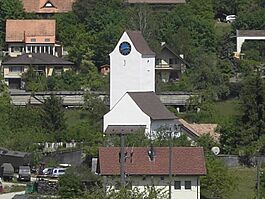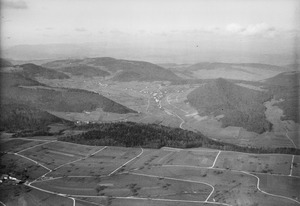Mönthal facts for kids
Quick facts for kids
Mönthal
|
||
|---|---|---|
 |
||
|
||
| Country | Switzerland | |
| Canton | Aargau | |
| District | Brugg | |
| Area | ||
| • Total | 3.94 km2 (1.52 sq mi) | |
| Elevation | 479 m (1,572 ft) | |
| Population
(Dec 2020 )
|
||
| • Total | 393 | |
| • Density | 99.75/km2 (258.3/sq mi) | |
| Postal code |
5237
|
|
| Surrounded by | Effingen, Elfingen, Gansingen, Oberbözberg, Remigen, Sulz | |
Mönthal is a small town, also called a municipality, located in the Brugg area of the canton of Aargau in Switzerland. It's a quiet place nestled in a valley.
Contents
History of Mönthal
Mönthal has a long history. It was first settled a very long time ago, during the late Bronze Age. People built a strong settlement on a hilltop here. Later, during the time of the Romans, a bronze statue was found in the village.
Early Settlements and Rule
In the High Middle Ages, around 1300, there were several small villages in this area. Some of these old houses are still standing today. Others, like a village called Bernbrunnen, have disappeared over time.
Mönthal itself was first mentioned in official records around 1273. At that time, it was known as Muenuntal. The powerful Habsburgs family controlled the area. They held the rights to make laws and judge people.
In 1460, control of Mönthal passed to Bern. Under Bern's rule, Mönthal became part of a larger area called the Schenkenberg bailiwick. A bailiwick was like a district managed by a local official. The main court for this area was in a place called Stilli.
Church and School
The church in Mönthal, named St. George's church, was also first mentioned in 1273. After 1380, the town of Brugg gained the rights to collect church offerings and choose the minister.
Later, after 1860, Mönthal became its own independent Reformed parish. This meant it had its own church community. However, in 2007, it joined with the Bözberg parish.
Mönthal has had its own school for a long time. The first school started in 1630. The school building we see today was built much later, in 1820.
Economy and Population Changes
In the 1700s, Mönthal became quite successful. This was thanks to growing grapes for wine and making things like linen and cotton at home.
However, after 1850, the number of people living in Mönthal and its economy started to shrink. It wasn't until 1970 that the population began to grow again. This growth was mainly because people who worked in nearby cities like Baden and Brugg moved to Mönthal.
Geography of Mönthal
Mönthal covers an area of about 3.93 square kilometers (about 1.5 square miles). A large part of this land is used for farming. About 45.3% of the area is farmland.
Forests cover an even bigger part of Mönthal. Around 46.1% of the land is covered by trees. The rest of the land, about 8.7%, is where buildings and roads are located.
Land Use Details
Within the built-up areas, about 4.6% is used for houses and other buildings. Roads and other ways to get around make up 3.1% of the land.
Looking at the agricultural land, about 20.6% is used for growing crops. Another 22.9% is used as pastures for animals. A small part, 1.8%, is used for orchards or vineyards.
Location and Layout
Mönthal is located in the Brugg district. It sits in a valley within the Jura Mountains. This valley is found between the towns of Brugg and Laufenburg.
The municipality includes the main village of Mönthal. It also has smaller areas called hamlets. One of these is Ampfern, which is on a hill called Ampfernhöhe. There are also other small, scattered groups of houses.
Mönthal's Coat of Arms
The official design of Mönthal's coat of arms is described as: Azure three piles inverted Or topped with as many Mullets of the same in chief.
This means the shield is blue (Azure). It has three golden (Or) pointed shapes that look like upside-down triangles (piles inverted). At the top of each golden shape is a golden star (Mullets).
People of Mönthal (Demographics)
Mönthal has a population of about 400 people. As of June 2009, about 8.8% of the people living here were from other countries. Over ten years, from 1997 to 2007, the population decreased slightly by about 4.1%.
Languages and Age Groups
Most people in Mönthal speak German. About 95.2% of the population speaks German. French is the second most common language, spoken by about 1.3% of people. Albanian is the third most common, also spoken by about 1.3%.
The age groups in Mönthal are quite varied. As of 2008:
- About 4.9% of the population are children aged 0 to 9 years old.
- About 13.3% are teenagers aged 10 to 19.
- Adults aged 20 to 59 make up a large part of the population.
- About 14.1% are seniors aged 60 to 69.
- About 6.6% are aged 70 to 79.
- A small number, about 1.9%, are aged 80 to 89.
Homes and Living
In Mönthal, about 67.1% of homes are owned by the people who live in them. This means they don't pay rent. As of 2000, there were many different household sizes. There were homes with just 1 or 2 people, and many with 3 or 4 people. There were also 74 homes with 5 or more people. On average, there were about 2.66 people per household.
In 2008, there were 103 single-family homes in Mönthal. This was about 58.5% of all homes and apartments. Only a few apartments were empty, showing a low vacancy rate of 1.7%.
Politics and Education
In the 2007 national election, the most popular political party in Mönthal was the SVP. They received 45.1% of the votes. Other popular parties included the FDP, the CVP, and the Green Party.
Many adults in Mönthal have a good education. About 71.2% of people aged 25 to 64 have finished either advanced high school education or gone on to higher education, like university.
Economy of Mönthal
Mönthal has a low unemployment rate. In 2007, only about 3.08% of people who wanted to work were unemployed.
Jobs and Businesses
As of 2005, there were different types of jobs in Mönthal:
- About 19 people worked in the primary economic sector. This includes jobs like farming and forestry. There were about 10 businesses in this area.
- About 25 people worked in the secondary sector. This includes jobs like manufacturing and construction. There were 5 businesses in this sector.
- About 20 people worked in the tertiary sector. This includes jobs in services, like shops or offices. There were 9 businesses in this sector.
Commuting and Transportation
Many people who live in Mönthal work outside the municipality. In 2000, about 85.8% of residents worked in other towns. However, some people also travel into Mönthal for work. There were about 55 jobs available in the municipality itself.
For getting to work, about 12.9% of people used public transportation. A larger number, 56.3%, used a private car to travel to their jobs.
Religion in Mönthal
Based on the 2000 census, people in Mönthal follow different religions:
- About 26.9% of the population were Roman Catholic.
- About 51.3% belonged to the Swiss Reformed Church.
- A small number, about 1.51%, belonged to the Christian Catholic faith.
See also
In Spanish: Mönthal para niños






